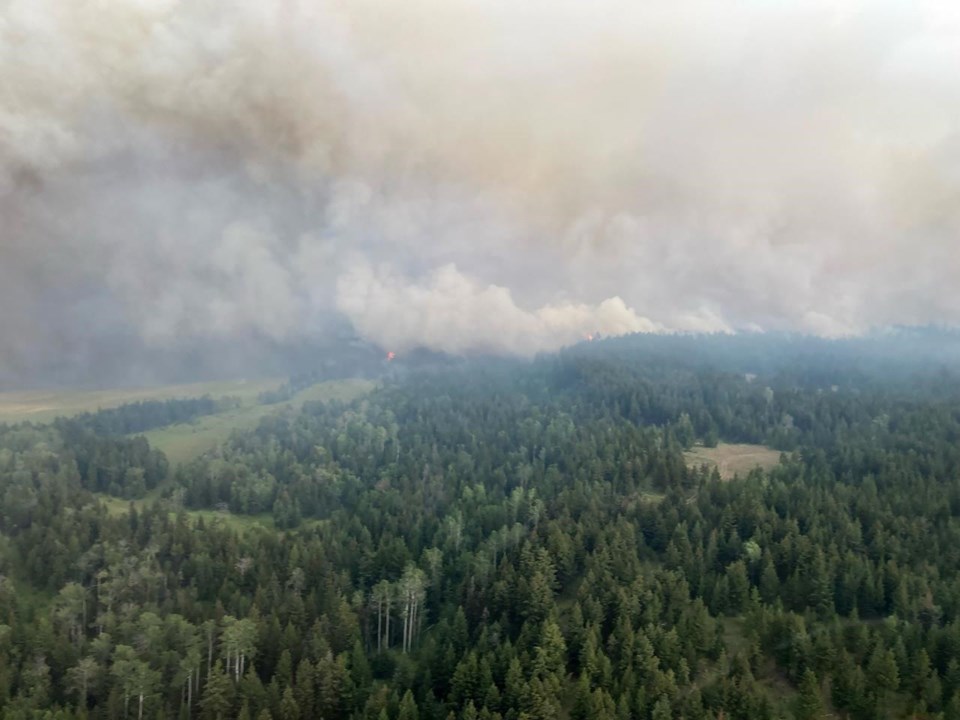VANCOUVER — The manager of an evacuated resort near the Ross Moore Lake wildfire in British Columbia's Interior said he could not believe how fast the fire grew over the weekend.
Jason Upton, manager of the Lac Le Jeune Nature Resort south of Kamloops, escaped to nearby Merritt with four staff members after the blaze came within a few kilometres of the property on Sunday.
Upton said he had been keeping track of the fire because it was so close to the resort and thought it was out on Sunday morning when he saw very little smoke.
But hours later, Upton and his staff were rushed out as visible flames approached.
"I would say the one thing that really was the biggest shocker out of this whole experience was how fast it could happen and move," he said. "I didn't ever expect it could move that fast."
The resort, which offers lodging on the lake, only just reopened this spring after a 3-1/2-year pandemic shutdown, Upton said.
The wildfire, located about 20 kilometres south of Kamloops, B.C., was discovered on Friday afternoon and is about 18-square kilometres in size.
The fire, which has been fanned by strong winds, is one of nearly 500 active wildfires across B.C., an increase of about 100 in recent days.
For the first time in more than a month, showers and cooler weather were reaching parched sections of the province on Monday, including Vancouver Island and Metro Vancouver, where Environment Canada was expecting about 20 millimetres of rain.
But the showers were spottier around Kamloops, with high temperatures forecast to return mid-week.
The rapidly growing Ross Moore Lake forced the evacuation Sunday of 344 properties in the area of Lac Le Jeune and Long Lake Road.
Thompson-Nicola Regional District information officer Colton Davies said in addition to the evacuation orders, another 127 properties are on evacuation alert and residents need to be prepared to leave on short notice.
Davies said smoke from the Ross Moore Lake fire is "extremely visible" from both the Coquihalla Highway and Highway 5A, and strong winds blowing northeast fanned the growth of the fire that spread smoke over Kamloops and other communities.
"When you are behind the fire near the Lac Le Jeune exit (Sunday), it was a clear blue day," he said of the smoke situation. "But Kamloops was very socked in with smoke, and other areas in that direction would be as well."
Rancher Doug Haughton told CHNL radio the Ross Moore Lake fire "blew up like a cannon" over the weekend, and he worked all day Sunday to evacuate his animals from the approaching fire.
Haughton, who is also director of Thompson-Nicola Regional District's electoral area L, said while he was lucky to get all of his animals to safety, some of his neighbours "have been hit very, very hard."
"It's not pretty up there," Haughton said of the fire. "Just looking from downtown Kamloops, it's nothing short of butt ugly."
Davies said the region's high temperatures and low humidity created an environment for the fire to spread quickly over the weekend, and the threat is persisting despite temperatures easing a bit on Monday.
"We're not expecting it to be as hot today, but it's still summertime in the Southern Interior," he said. "And we are expecting, just looking at the forecast, more winds today, which is never ideal for fire situations."
The wildfire danger rating is high to extreme across southern B.C., including around Cranbrook, where a week-old blaze has charred 40 square kilometres, forcing evacuations and alerts for hundreds of properties.
East Kootenay Regional District emergency operations information officer Loree Duczek said residents of 16 homes in the Aq'am First Nation community were able to return after an evacuation order was rescinded, but those residents remain on alert.
In total, 677 homes in the area remain on alert for possible evacuation, while 51 homes are under an evacuation order.
As of Monday, the wildfire service is reporting 481 active wildfires across the province, with 274 classified as out of control.
In total, British Columbia has seen 1,463 fires to date in 2023, burning just under 15,000 square kilometres of land.
This report by The Canadian Press was first published July 24, 2023.
The Canadian Press




